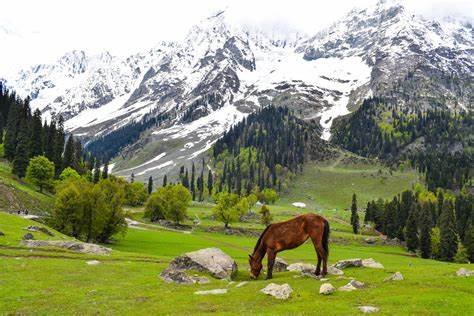Kashmir, once described as paradise on earth, now finds itself struggling under the weight of a tragedy that shattered its spring season. The April 22 terror attack in Pahalgam not only stole lives—it stole trust, dreams, and an entire season of hope. Tourists have vanished, leaving behind shuttered shops, empty shikaras, and the silence of snow-covered slopes without footprints.
BY Pravin Kumar
In the heart of Kashmir, where the Lidder River once sang lullabies to the pine-clad hills of Pahalgam, the air now carried a heavy silence. Just a month ago, Srinagar’s airport buzzed with life—100 flights crisscrossing the skies daily, ferrying 16,000 to 18,000 passengers to the paradise that was Kashmir.
Tourists flocked to Pahalgam’s meadows, Gulmarg’s snow-dusted slopes, and the serene lakes of Sonamarg, their laughter mingling with the calls of shikara rowers on Dal Lake.
The valley was alive, its pulse beating through the bustling markets and crowded houseboats.
But that was before the Pahalgam terror attack.
READ: EaseMyTrip Shares Tumble as CEO Pitti Named in Scam
On April 22, a group of heavily armed terrorists stormed Baisaran meadow, a popular tourist trail, killing 26 tourists, including a local ponywallah, before fleeing. A brutal attack that tore through the valley’s soul, its echo louder than the gunfire itself.
As news spread like wildfire, searing through headlines and social media. The world recoiled, and so did the tourists.
Within days, cancellations flooded travel agencies, and Srinagar’s airport grew eerily quiet. The hum of 100 daily flights dwindled to fewer than 50, with only 5,000 to 7,000 passengers trickling through the terminals. The valley, once a tapestry of vibrant colors and sounds, now felt like a painting left unfinished.
*Date: 20 May 2025*
Arrival Flights: 21
Departure Flights: 21
Total Flights: 42
Arrival Pax: 2988
Departure pax: 2794
Total Pax: 5782— Srinagar Airport (@SrinagarAirport) May 21, 2025
In Pahalgam, Gulzar Ahmad (name changed) sat outside his shuttered handicraft shop, his hands idle for the first time in decades. The shelves behind him, once brimming with intricately woven shawls and carved walnut wood souvenirs, gathered dust. “This was our season,” he murmured, his breath visible in the chilly air.
READ: Ashoka Professor Gets Bail Amid Free Speech Row
“Families would come, children running through the streets, bargaining for trinkets. Now, look—empty.” The main street, usually thronged with visitors snapping photos of the snow-capped peaks, was deserted, save for a stray dog nosing through litter.
In Gulmarg, the ski lifts hung motionless, their cables swaying in the wind. Shabir, a ski instructor who had taught foreigners to glide down the powdery slopes for years, leaned against his shack, staring at the untouched snow. “Last year, I had bookings till March,” he said, his voice low. “Now, I don’t know if I can pay for my daughter’s school fees.” The gondola operators, pony wallahs, and tea stall owners shared his despair, their livelihoods tethered to the tourists who no longer came.
Srinagar’s Dal Lake mirrored the gloom. Houseboat owner Naseema stood on her deck, her eyes scanning the still water. Her boat, Gul-e-Bahar, once hosted honeymooners and families, its wooden interiors alive with stories and laughter. Now, it rocked gently, empty. “They called it paradise,” she whispered. “But paradise doesn’t survive fear.” The shikara rowers, docked along the lake’s edge, shared murmurs of unpaid loans and hungry children.
In Sonamarg and Tangmarg, the story was no different. Hotels stood like hollow shells, their staff let go or worked for scraps. The local economy, so deeply entwined with tourism, unraveled thread by thread. Guides, drivers, artisans, and vendors—all sat there empty-handed and counted losses instead of guests. The vibrant chaos of the markets had been replaced by a haunting stillness, broken only by the occasional military patrol.
Yet, amidst the despair, there were flickers of resilience. In a small café in Srinagar, a group of locals gathered, determined to reclaim their valley’s spirit. “We’ve survived worse,” said Ayesha, a young entrepreneur who ran a homestay. “This fear will pass. We’ll tell the world Kashmir is more than headlines—it’s our home, our heart.” They spoke of community initiatives, of reaching out through social media to share the valley’s beauty, urging travelers to return.
On Sunday, stakeholders associated with the Tourism Industry organised a motor rally from Dal Lake to Pahalgam to send a loud and clear message to the outside world to visit the Kashmir valley.
The rally could not complete its run. It was stopped at Anantnag due to security reasons. For now, the Valley is waiting for its visitors to return soon.













